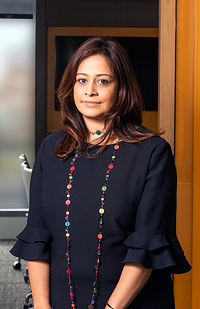Tina Adatia, CFA profile

Author: Maha Khan Phillips
Tina Adatia, CFA, talks to Professional Investor about ESG innovation in fixed income, the CFA Program, experiences from her own career, and what lessons she would pass on to those just starting out.
Studying the CFA Program helped Tina Adatia, CFA, with an early job interview. It was 2004, and she was applying for a graduate role with PIMCO, the fixed income-focused manager. “I remember it so well. I did my Level 1 exam on Saturday, December 4, and I started working at Pimco two days later. I actually used Level 1 to prepare for my interview. The interview process tested my fixed income and financial markets knowledge and was more technical than I would have expected. The CFA Program prepared me and allowed me to take on a role somewhere that was quite technically-minded,” she says.
That was 18 years ago. Adatia is now Global Head of ESG Product Strategy and Global Fixed Income Strategies at PIMCO. She had joined the firm after short stints with Bacon & Woodrow (now Hewitt) and Henderson Global Investors, having studied economics and actuarial science at the University of Southampton. Early on, Adatia realised that she wanted to move away from the actuarial route, and work on the asset management side of the business.
At PIMCO, she has worked across a variety of different roles, including as an account manager focused on the Middle East and North Africa region, servicing institutional clients including sovereign wealth funds and central banks. “I covered Middle East official institutions and that was really eye opening, because I had spent most of my career to date focused on pensions, which are liability-focused and operate under a different set of constraints and objectives to official institutions, which tend to have a different starting point.”
In her current role, she is responsible for core and global fixed income within PIMCO’s product strategy group. She has also taken on a wider leadership role in product strategy for ESG. The shifting ESG landscape has had significant implications for the world of fixed income, she says. “We have a chance to work with clients to build sustainable solutions to meet their ESG requirements. This involves setting measurable objectives in terms of ESG outcomes, ensuring you have an understanding of the appropriate data sources and a mutual agreement of what success means for the client. As an example, different clients are at different stages of their ESG journey, with some trying to avoid specific sectors and issuers, and others looking to allocate to ESG leaders. Now we also have a growing group of clients who have made net zero commitments and are starting to think about making the ESG transition in their investment portfolios.”
While clients have spent a lot of their time looking at equities through an ESG lens, they are sometimes unsure about how to tackle the sustainability and stewardship components of fixed income, she adds. “It’s important for clients to consider sustainability risks in their fixed income portfolios and the fixed income asset class offers an opportunity for investors to drive positive change. Specifically due to the size of the global fixed income market and the fact that bond issuers are required to come to the market on a number of occasions as they re-finance their obligations, asset managers get lots of opportunities to engage with issuers. Examples of positive engagement can be speaking with the issuer on their net zero ambition, guiding an issuer on disclosures, and working with issuers on ESG bond issuance,” she says.
Specifically, on ESG bonds or use of proceeds bonds, issuance has increased significantly, and is a great example of ESG innovations in the fixed income market, she says. “ESG bonds such as green, social or sustainability-linked bonds are great tools that can be used to finance specific projects. They allow you to work with issuers on targeted projects that can accelerate the corporate’s ESG transition. An interesting sub-sector of the ESG bond market are sustainability-linked bonds. Here you can work with issuers to include covenants or set-up structures that include coupon step-ups if targets aren’t met. This is a really interesting innovation and unique to the fixed income market.”
Adatia encourages anyone starting out their investment career to grab as many opportunities as they can. “Do things that will push you out of your comfort zone. Seek out mentors. Ask difficult questions and set realistic goals. Challenge yourself but recognise that this is not a race. When I was early in my career, I saw everything as a race, from getting the CFA done, to getting promoted. Looking back, there were probably times when I should have taken the time out to travel or do things I enjoyed. The reality is that you need to find a balance that works for you and focus on your own goals as this is likely to lead to a more successful and sustainable career longer term.”
And for those who are considering the CFA Program, Adatia has one key piece of advice: start early if possible. “I would encourage people to do the CFA Program as soon as they can and not put it off. One of the reasons I found the CFA so useful was because I had some gaps in my knowledge. When you are at university there are things you don’t learn. A combination of on-the-job experience and the CFA Program can provide a good foundation when you are starting out – plus it’s easier to do it when you have less going on in your life.”
Tina Adatia, CFA,Head of ESG Product Strategy & Global Fixed Income Product Strategy, Pimco
